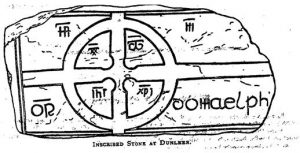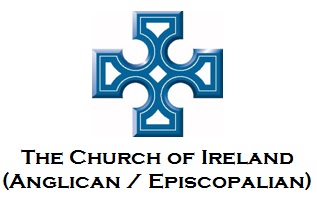DUNLEER CHURCH
Freestanding Church of Ireland church, built 1830, comprising four-bay nave with thirteenth century three-stage crennellated tower to west and later nineteenth century chancel to east. Pitched slate roof. Roughcast rendered walls. Pointed arch, round-arched and squared headed openings with limestone dressings. Double-leaf timber matchboard doors with strap hinges. Retaining medieval inscribed slabs and eighteenth and nineteenth monuments. Tenison family mausoleum to site. Pair of ashlar limestone gate piers with wrought-iron gates to west.
APPRAISAL
Designed by William Farrell in the first part of the nineteenth century, this fine church is thought to be built on the site of the abbey of Lann Leire. The site retains fabric from the thirteenth to the twentieth century, such as the entrance tower, mausoleum and monuments, which provide evidence of the continued use and importance of it in the local area and county. (from NIAH survey)
CLERGY OF THE PARISH OF DUNLEER
(from an article by Padraig Faulkner, in Louth Historical and Archaelogical Journal, Vol XXIII, no. 2 1996
Lannléire is the ancient name of Dunleer. The monastery of Lannléire was founded by the brothers, Furudran and Baothan, in the sixth century, and so, under both names, Lannléire and Dunleer, the district has a recorded history of 1,400 years. Furudran and Baothan succeeded one another as abbots of the monastery of Lannléire. Their feast day falls on 18th June.
Dunlere, Dunler, (Dunleer): The name Dunler appears as early as 1212 in Pontificia Hibernica. It was then in the possession of the Knights Hospitallers of Jerusalem.
VICARS OF DUNLEER:
Simon de Napton parson of Dunler about 1220
Walter Haddesore vicar of Dunler and dean of Drogheda. He summoned the clergy of his deanery for 21st June 1367 and laity of every parish for 22nd June 1367 at St Peter’s, Drogheda.
John Darcy 1402
Thomas Nanny resigned as vicar, 1415
Robert Sweteman 1415
Patrick O’Mulchallyn 1450
Walter More 1485
John Lang deprived of the vicarage for non-residence 1490
Geoffrey Hurdi 1497
John Theoderici 1513
James Brune died 1519
John Ardagh 1519, still living in 1522
Andrew Barnwall resigned in 1544
Richard (Henry) Hyng 1544
Richard (Henry) Hyng was appointed to the perpetual vicarage of the Holy Confessors, Fretanus and Brethanus of Dunleer. He was inducted 11th September 1544. It is probable that Richard Hyng (Henry) was the last vicar of Dunleer to conduct religious services at Dunler in accordance with the Catholic rite.
EARLY CHRISTIAN GRAVESLABS


This stone is lying with two other stones, bearing crosses (but no inscriptions) in the porch of the Church of Ireland in Dunleer. It is a slab of sandstone, 3 feet 3 inches by 1 foot 8 inches by 2¼ inches. The end of the stone is broken off, but otherwise the condition is good. This fracture, however, takes off the most important part of the owner’s name, which was probably Mael-Phalraio; the inscription is in the usual formula:
OR (oit) DO MAELPH……. “a prayer for Mael-Ph….”
In the cross-head, the stone bears the Alpha and Omega, as well as the letters IHC XPC, found on a few of these slabs, such as those at Glendalough and Tullylease. In the other cantons are groups of three strokes. Are these for an M, standing for MARIA? I can think of no other explanation. If it be correct, the stone is symbolically unique among early Christian slabs in Ireland. Compare the M in the initial of the name on the stone.
a = alpha, symbolizing the beginning v = omega, symbolizing the end.
IHC = an abbreviation for the name JESUS
XPC = an abbreviation for the title CHRIST
Ἰησοῦς (ὁ) Χριστός: “Jesus (the) Christ”,
